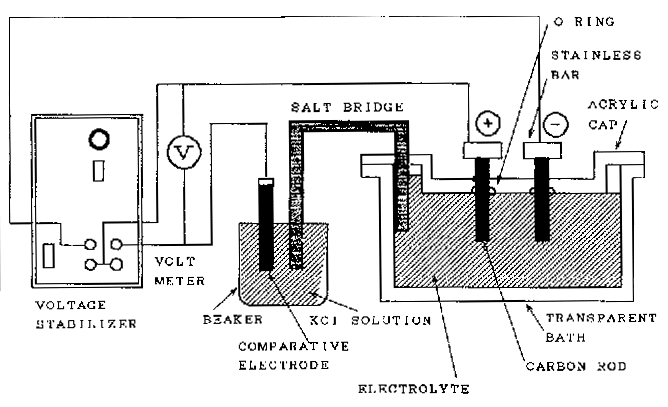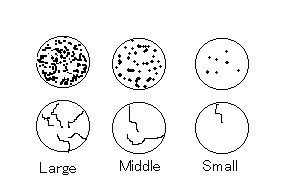ELECTROLYTE LEAKAGE
When Carbon Rods are assembled into Batteries, they are always
given voltage. And electrolysis is constantly performed even
when the current is not discharged. Thus, it was considered
nearly impossible to detect electrolyte leakage defects on
Carbon Rods, unless Carbon Rods are actually assembled into
real Batteries. Moreover, we have to wait for a long time
to see the results.
The apparatus as shown below have been designed to test
Electrolyte Leakage through Carbon Rods under the conditions
very similar to real Batteries in a very short period of time.

1. Equipments
1) Transparent Bath made of acrylic plastics
2) Transparent Cap Plate
3) O ring P-0 112 pcs.
4) Stainless Bar 8 pcs.
5) Salt Bridge
6) Beaker
7) Saturated KCl solution
8) Comparative Electrode
9) Digital Volmeter
10) Voltage Stabilizer (+/- 2mV)
11) Electrolyte (ZnCl 10%, NH4Cl 22%, Surface Activator 0.01%)
12) AgNO3 (5% solution)
2. Procedurers
1) Put O Rings in the holes of Acrylic Cap Plate, and grease
the rings and around the holes.
2) Put the Acrylic Cap Plate on the Stainless Bars upside down.
3) Insert the sample Carbon Rods through the holes, and fix
the tops of the Carbon Rods on the Stainless Bars one by
one using a rubber hammer.
4) Fill the Transparent Acrylic Bath with electrolyte.
5) Put the prepared Cap Plate on the Bath.
6) Adjust the level of electrolyte.
7) Connect the Stainless Bars, Salt Bridge, Comparative
Electrode, Voltmeter and Voltage Stabilizer.
8) Adjust the voltage on Voltmeter at 1050mV. This adjustment
should be done at least once a day during the test periods.
The test periods: 7 days for 8mm Oil impregnated Carbon Rods
8 days for 8mm Wax impregnated Carbon Rods
3. Judgement
1) As soon as the test period is over, examine if electrolyte
bubbles are witnessed on the test piece above the Acrylic
Cap Plate level.
2) Take out the test piecees from the Cap Plate, and wash them
well with water.
3) Cut off the Carbon Rods at 5mm above the surface level of
electrolyte. This level can be easily observed by
changed color on the Carbon Rods test pieces.
4) By applying AgNO3 solution to the cut-face of the test piece,
and examine if electrolyte is leaked inside of the test piece.
The electrolyte leakage can be judged by white dots or
marks to be shown on the cut-face. See the typical patterns
of judgement below.
5) Cut the test piece into half, and examine the electrolyte
leakage according to the same procedures as described above.

Back

